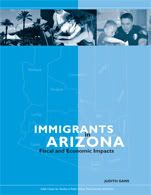New study shows undocumented immigrants good for Arizona economy
 We can now add Arizona to the long list of states in which recent studies prove that the current influx of immigrants, both legal and undocumented, have contributed far more in taxes than they receive in government services.
We can now add Arizona to the long list of states in which recent studies prove that the current influx of immigrants, both legal and undocumented, have contributed far more in taxes than they receive in government services.
Joining studies from California, Texas, Florida, New Mexico, Washington DC, and Long Island, NY, a new report from Udall Center for Studies in Public Policy at The University of Arizona looks at the contributions and costs of Arizona's immigrant population and finds not only an overall net gain for the state, but that the loss of this population would likely cause long term economic problems.
At a time when states like Georgia, Oklahoma and Colorado, and municipalities large and small all over the country, are passing harsh legislation intended to drive off their immigrant populations, this Arizona study concludes that, in the long run, these restrictionist tactics will end up creating economic disaster for certain segments of the economy and an overall loss for all residents. These finding don't bode well for the state which already has some of the toughest anti-immigrant laws in the nation.
The study is also unique in that it breaks out the non-citizen population from the rest of the immigrant population and still comes to the same overall conclusions.
This is a important development, since one of the restrictionsts chief weapons in their war of misinformation has been the lack of information on the contributions of the undocumented versus the larger immigrant population.
This has allowed them to wrongly discount or discredit many of the previous studies by claiming that undocumented are somehow different than the broader immigrant population in their use of services or contributions.
Based on this study, the total state tax revenue attributable to immigrant workers was an estimated $2.4 billion, of which about $1.5 billion came from for non-citizens. Balanced against estimated fiscal costs of $1.4 billion (for education, health care, and law enforcement), the net 2004 fiscal impact of immigrants in Arizona was positive by about $940 million.
The 2004 total economic output attributable to immigrant workers was about $44 billion, $29 billion of that coming from non-citizens. This output included $20 billion in labor and other income and resulted in approximately 400,000 full-time-equivalent jobs.
The study also looks at what impact the removal of as little as 10-15% of the immigrant workforce would have on the state's economy. Over $.5 billion in tax revenues would be lost, 125,000 jobs and $13.5 billion of lost economic output.
Clearly, lawmakers from statehouses to city councils across the country should examine this study before they begin to contemplate the adoption of restrictionist tactics and harsh legislation when addressing this issue. …..like the old saying goes:
"Be careful what you wish for … or you just might get it." Immigrants in Arizona: Fiscal and Economic Impacts
by Judith Gans
Udall Center for Studies in Public Policy at The University of Arizona.
Preface
Arizona’s foreign-born population has grown dramatically since 1990 when there were about 268,700 foreign-born persons in the state. By 2004, the foreign-born population had grown to 830,900. This is more than a 200 percent increase. The vast majority of these new immigrants are in the non-citizen category, which went from 163,300 to about 619,800, an increase of almost 280 percent. Most immigrants are of working age and have come to the United States seeking employment. This fact is central to their impacts in Arizona.
The likelihood that many of Arizona’s non-citizens are undocumented immigrants has fueled anger over lawlessness and made discussion of immigration in Arizona politically contentious. But Arizona’s experience is a specific case of a national problem, one that exists because large economic incentives in today’s global economy are overwhelming the U.S. immigration system – a system that is widely understood to be in need of reform. Public discourse that equates immigration and illegal immigration is narrowly focused and risks overlooking broader dimensions of the role of immigrants in the economy.
It is not the purpose of this study to address the myriad issues surrounding illegal immigration or to imply in any way that illegal immigration is not a problem. Rather, the objective of this study is to suspend, for the moment, discussion of this narrow topic and focus instead on a broader examination of all immigrants’ impacts on Arizona’s economic and fiscal health. By so doing, we hope to create a more thorough understanding of the economic costs and benefits of immigration and of the tradeoffs involved in setting and enforcing immigration policy.In Brief
Arizona’s proximity to Mexico, the growth of its immigrant population, and the proportion of immigrants that are in the United States illegally have made immigration a contentious issue. This study is intended to step back from debates over illegal immigration and deepen our understanding of the costs and contributions of immigrants to Arizona’s economy.Executive Summary
This report examines the costs and benefits of immigration in Arizona. It provides estimates of the of incremental fiscal cost associated with immigrants – education, health care, and law enforcement – and measures their contributions to Arizona’s economy both as consumers and as workers. The two categories of immigrants (naturalized citizens and non-citizens) are examined separately in order to disentangle the economic costs and benefits associated with each.
The bottom line
Based on this study, the total state tax revenue attributable to immigrant workers was an estimated $2.4 billion (about $860 million for naturalized citizens plus about $1.5 billion for non-citizens). Balanced against estimated fiscal costs of $1.4 billion (for education, health care, and law enforcement), the net 2004 fiscal impact of immigrants in Arizona was positive by about $940 million.
The 2004 total economic output attributable to immigrant workers was about $44 billion ($15 billion for naturalized citizens and $29 billion for non-citizens). This output included $20 billion in labor and other income and resulted in approximately 400,000 full-time-equivalent jobs.
Fiscal costs of immigration
Estimates of the incremental fiscal costs of immigration were derived from a variety of sources. In summary:
The total cost in 2004 of Arizona Health Care Cost Containment System (AHCCCS), Arizona’s Medicaid program, was $4.3 billion, of which an estimated $640 million was incurred by immigrants. Of the $640 million in AHCCCS costs associated with immigrants, about $480 million was incurred by non-citizens.
Immigrants as consumers
As consumers, immigrants bring considerable spending power to Arizona’s economy. This spending contributes to Arizona’s overall economic performance, and, in turn, generates tax revenues for the state.
This output included labor income of $1.2 billion, and other income (defined as rents, royalties, dividends, and corporate profits) of $900 million.
Consumer spending in 2004 by non-citizen households in Arizona was an estimated $4.4 billion. Approximately 28,000 full-time equivalent jobs can be attributed to this spending along with $4.3 billion of output in the state’s economy. This output included labor income of about $930 million, and other income (defined as rents, royalties, dividends, and corporate profits) of $560 million.
Consumer spending in 2004 by Arizona’s non-citizens generated tax revenues of approximately $320 million, consisting of personal taxes of nearly $36 million, sales taxes of $150 million, and business taxes of about $130 million.
Immigrants as workers
Immigrants in 2004 were 14 percent of Arizona’s workforce, and were a larger proportion of low-skilled labor in agriculture, construction, manufacturing, and certain service industries. High-skilled immigrants were a large percent of the workers in specific areas of medicine and science.
In low-skilled occupations in Arizona:
In high-skilled occupations in Arizona:
Economic contributions of immigrant labor
Approximately $15 billion, or four percent, of the state’s output can be attributed to naturalized citizen workers, resulting in about 120,000 full-time-equivalent jobs. This output included $4.9 billion in labor income and $1.9 billion of other income in the state. State tax revenues resulting from this economic activity were approximately $860 million.
Non-citizens, for their part, contributed about $29 billion, or eight percent of Arizona’s economic output, resulting in about 280,000 full-time-equivalent jobs. Their output included $10 billion in labor income, and $3.3 billion in other property income. The state tax revenues resulting from this economic activity were approximately $1.5 billion.The role of immigrants as workers can be further understood by analyzing the potential consequences of this source of labor not being available. In other words, what would be the impacts if immigrant labor were removed from the economy?
To this end, this study used a series of computer simulations to examine the impacts of reduced immigrant labor on the industries that employ relatively large numbers of immigrants. The study focused on industries employing low-skilled, non-citizen workers because this is where recent growth in Arizona’s immigrant population has occurred and because we know that significant numbers of these workers are in the country without authorization. Thus, the simulations are designed to estimate the economic consequences of eliminating this segment of the workforce.
Net fiscal impacts of immigrants
Total state tax revenue attributable to immigrant workers was estimated to be about $2.4 billion ($860 million for naturalized citizens plus $1.5 billion for non-citizens). Balanced against estimated incremental fiscal costs of $1.4 billion, the net 2004 fiscal impact of immigrants in Arizona was positive, by approximately $940 million.
As 14 percent of the workforce, immigrants make significant contributions to Arizona’s economy. There are also specific fiscal costs associated with immigrants. But, by virtue of their contributions as workers to Arizona’s economic output, their overall contribution to the state’s fiscal health is positive. Certainly, these impacts are changing over time, but looking at data for one year provides a snapshot of the extent and magnitude of the role of immigrants in Arizona’s economy.
Note: We have estimated the incremental (marginal) costs of immigrants as individuals. If the immigrants were not present in Arizona, these costs would disappear. Immigrants’ impacts on costs of social services, such as fire and public safety protection, are not estimated because it is not possible to measure the incremental costs attributable to immigrants for these services.
Read complete report
UPDATE: 10/16/07: 7:30 EDT
Some questions have been raised at various other sites about two aspects of this study. One is the standard question about breaking down the numbers for just the undocumented population as oppossed to the non-citizen population as a whole.
The other questioning the extrapolations made about the economic costs of losing a portion of the undocumented workforce and the possible replacement of those workers with US-born workers.
the study answers both those questions:
How much of Arizona's immigrant population is here illegally?
We do not know. The U.S. Census does not ascertain legal presence in the United States when conducting its surveys and so the non-citizen category includes both legal and illegal non-citizen immigrants. However, there are reasonable, statistically derived estimates. Research by Jeffrey Passel at the Pew Hispanic Center indicates that, in 2002, there were between 250,000 and 350,000 unauthorized immigrants in Arizona, most of whom came from Mexico, and that by 2005 their numbers had increased to as many as 500,000.
Given these numbers it's statistically safe to estimate that somewhere around 80% of the non-citizen population is in fact undocumented in Arizona. This allows us to extrapolate the statistics given on the "non-citizen" population to see what's occurring with just the undocumented portion of that population.
As to the extrapolations made about the effects of the removal of the undocumented population on the economy and the likelihood that US-born workers would step up to fill the gap:Our analysis to this point has focused on measuring the portion of Arizona's economic activity attributable to immigrants in its workforce. This raises the following question: would the jobs filled by immigrants be taken instead by native-born workers if immigrants were not part of the labor force in Arizona? The answer to this question is complex but largely depends on the availability of native-born workers with skills similar to Educational attainment data, both for Arizona and for the United States, indicate that immigrants and native-born workers tend to have different skills, with immigrants filling specific gaps in the native-born workforce by providing needed low-skilled and high-skilled workers. Immigrants in Arizona are an important source of low-skilled labor and of specific high-skilled labor that is relatively scarce in the native-born population and thus are vital to the total output of the industries that employ them. It is difficult to make the case that all or even most jobs filled by immigrants would, instead, be filled by native-born workers if immigrant workers were not available.

































2 comments:
Thank you for posting this. I might have to use it in my own blog, and worth noting, Arizona is not exactly a liberal state.
Think Dobbs will report this on his show?
Post a Comment